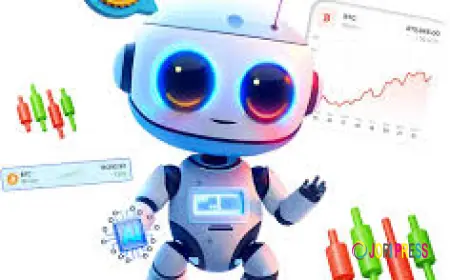E-Commerce 2025: AI, Speed & Personalized Shopping
E-commerce in 2025 is powered by AI, voice search, AR, and hyper-personalization—delivering faster, smarter, and more seamless shopping experiences online.
E-commerce in 2025 is changing how we shop, and the shift is driven by speed, artificial intelligence, and tailored shopping experiences. The ability to order everything from orion vapes to household appliances within minutes has reshaped our daily habits. Digital stores are now faster, smarter, and more intuitive than ever before. Mobile platforms have become the center of attention as more people prefer shopping from their phones. In this setup, personalization plays a key role, helping customers make quicker and better choices.

The Role of Artificial Intelligence in E-Commerce
AI has become the backbone of most major e-commerce platforms. Whether it's search results, product recommendations, or customer service, artificial intelligence makes the entire process more efficient and accurate. Here's how:
-
Smarter Product Recommendations: AI analyzes past purchases, browsing habits, and user preferences to suggest products tailored to individual users.
-
Virtual Shopping Assistants: Chatbots and virtual agents can now handle customer queries, track orders, and even recommend products.
-
Image & Voice Search: Platforms now allow shoppers to upload a photo or use voice commands to find items, making product discovery faster.
-
Inventory Optimization: AI helps businesses predict demand, avoid overstocking, and manage their inventory more effectively.
-
Fraud Detection: Security systems powered by AI monitor suspicious activities and protect both buyers and sellers.
Online retailers are integrating AI into every stage of the shopping experience to make interactions smoother and more intuitive. This also reduces wait times and improves the accuracy of search results, which keeps customers coming back.
Instant Deliveries and Faster Fulfillment
Speed is no longer just an advantage—it’s an expectation. Customers now want same-day or even two-hour delivery, and e-commerce businesses are adjusting to meet those demands. Several trends are shaping the future of fast delivery:
-
Micro-Fulfillment Centers: These small warehouses located in urban areas reduce delivery time and costs.
-
Drone and Robot Deliveries: Some companies have already started testing these options to reach customers in under 30 minutes.
-
Real-Time Order Tracking: Customers can now see the exact status of their order, from warehouse to doorstep.
-
Smart Warehousing: Automation in warehouses, including robots and AI sorting systems, reduces manual effort and speeds up order processing.
Retailers are investing in technology and logistics infrastructure to ensure that customers receive their products quickly. This not only improves customer satisfaction but also builds trust and loyalty.
Personalized Shopping Experience
Personalization is one of the most effective tools in modern e-commerce. It helps users discover what they want without having to search too hard. Whether it’s lush ice vape or running shoes, platforms use algorithms to put the right product in front of the right user. Here's how personalization is working in 2025:
-
Tailored Homepages: Every visitor sees a different homepage, based on their shopping behavior and interests.
-
Dynamic Pricing: Some retailers adjust prices in real-time based on demand, availability, and customer profiles.
-
Custom Offers and Discounts: Loyal customers or frequent buyers often receive personalized coupons and time-sensitive deals.
-
Product Customization: Users can now personalize products—like choosing flavors, sizes, or designs—before purchasing.
This type of customization helps customers make quicker buying decisions and increases the likelihood of repeat purchases.
Mobile Commerce and Seamless Checkout
The majority of shoppers in 2025 are using mobile devices to browse and buy products. E-commerce platforms are optimized for mobile, and payment systems have been simplified to reduce cart abandonment. Important trends include:
-
One-Click Checkout: Saves customer information for faster transactions.
-
Mobile Wallet Integration: Payments via services like Apple Pay, Google Pay, and others are widely accepted.
-
Biometric Authentication: Fingerprint and facial recognition provide secure and fast logins.
-
App-Based Loyalty Programs: Shoppers are rewarded through points or exclusive deals when they use mobile apps.
Mobile commerce is helping online retailers connect with users more personally, offering them convenience on the go. These improvements have significantly increased conversion rates and user retention.
How AI and Speed Redefine Online Buying
Beyond Traditional Shopping
In 2025, e-commerce is more than just browsing and clicking—it's an intelligent system that understands, reacts, and delivers. The role of automation and instant data processing allows companies to focus more on creating better experiences rather than just processing orders. Some additional points to consider:
-
Voice Commerce: Users can now complete purchases through smart speakers and voice assistants without touching a screen.
-
Augmented Reality (AR): AR tools allow shoppers to visualize furniture in their home or try on products virtually before buying.
-
Sustainability in Logistics: Faster delivery does not mean more waste; many companies are switching to eco-friendly packaging and optimized routes.
Consumers benefit by getting products faster, with more options and confidence in their purchases. For businesses, this shift leads to higher engagement, repeat purchases, and lower return rates.
Building Customer Loyalty with Technology
Technology is not just about speed; it's also about building relationships. Brands are using analytics and customer feedback to make improvements that matter. Strategies include:
-
Post-Purchase Communication: Customers are kept in the loop about delivery updates and follow-up offers.
-
Membership Programs: Subscription models with free delivery or special perks are becoming more popular.
-
Efficient Returns and Exchanges: Simplified return policies and faster refunds build trust.
The entire purchase cycle—from discovery to post-delivery—is now influenced by user preferences and automated systems that save time and effort.
Conclusion
E-commerce in 2025 is driven by three major factors: artificial intelligence, delivery speed, and personalized shopping experiences. These elements work together to create a system where shoppers find what they want quickly and receive it even faster. From AI-powered product recommendations to real-time delivery updates and voice-enabled purchases, the online shopping experience has never been more connected or efficient. Even categories like aloe grape flavors and other vape products are easily discoverable and available with just a few clicks. This evolution in digital retail is not only helping customers shop smarter but also encouraging long-term brand loyalty in a highly competitive market.
What's Your Reaction?
 Like
0
Like
0
 Dislike
0
Dislike
0
 Love
0
Love
0
 Funny
0
Funny
0
 Angry
0
Angry
0
 Sad
0
Sad
0
 Wow
0
Wow
0

















































